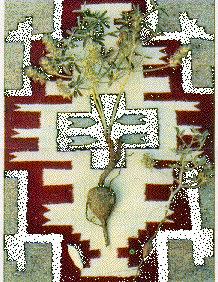


Timpsula produces a spindle-shaped tuber about four inches below the ground. This tuber, although nutritionally similar to a potato, differs in taste and texture due to different types of sugars and starches. The white edible portion is exposed by removing a coarse brown husk. If the thin portion of the root is left attached, the tubers can be woven together into an arm-length bundle for easy drying and transport. When air dried, the tubers can be stored indefinitely.
Timpsula has been a source of food and commerce on the Great Plains for centuries. The tuber can be eaten raw, cut into chunks and boiled in stews, or ground into a fine flour. The flour can then be used to thicken soups, or made into a porridge flavored with wild berries. Mixed with berries, water and some tallow, the flour can be made into cakes, which when dried, make a durable and nutritious trail food.
Historically, tinpsila occurred in prairies throughout the Great Plains from Saskatchewan to north Texas. In the Dakotas it is still relatively common in prairie tracts that have not been plowed or grazed too heavily. It flowers in May and June and ripens in June and July. It's important to know when the plant ripens because, if collected too early, the roots are limp and depleted from initiating spring growth; look too late, and the above-ground plant will be gone because it breaks loose at ground level and blows across the prairie like a tumbleweed spreading its seeds. It is no accident that, in Lakota, the month of June is called tinpsila itkahca wi, meaning the moon when breadroot is ripe.
Think of it as food for the now extinct Plains grizzly, who, according to William Clark, dug it with a passion. The wandering Sioux traded it to the Arikara for corn. Tinpsila even enters the renowned legend of John Colter's escape from the Blackfeet, because it supposedly became his survival food. It was undoubtedly eaten by Hugh Glass on his famous crawl across the South Dakota Plains after being mauled by a grizzly in 1823.
Harvey Dunn's memorable painting "The Prairie Is My Garden" depicts a pioneer woman and her children collecting flowers from nature's garden. When you eat fry bread made from timpsula, you are truly eating from our prairie garden.